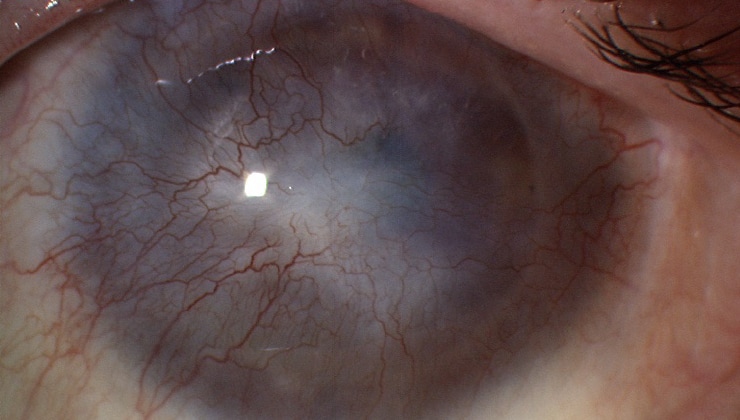What does it involve?

The scleral-corneal limbus is a transition zone, a ring surrounding the cornea, in which the cornea and surrounding conjunctiva join. This peripheral zone of the cornea also contains corneal epithelial stem cells, which, after growing in the limbus, migrate over the cornea from the periphery towards the centre, where they are eventually lost by desquamation.
There are a number of congenital or acquired factors that can seriously damage the limbus and, consequently, the stem cell population, causing a condition known as limbal stem cell deficiency syndrome. Limbal stem cell deficiency is caused when there is no longer a limbal stem cell source for corneal epithelial cells. The result is an invasion of conjunctival epithelial cells over the cornea, which take advantage of the fact that the limbus has ceased to act as a barrier to inhibit the growth of the conjunctiva.
The expansion of the conjunctival epithelium over the cornea causes vision loss, as well as epithelial adhesion problems, corneal erosion and ulcers, chronic inflammation and abnormal blood vessel growth. When the limbal stem cell deficiency has not yet fully developed, it can be treated with eye drops. In severe cases, however, limbal stem cell transplantation is the best option.
When is it carried out?

When the limbal stem cell deficiency has not yet fully developed and its cause has been eliminated with the help of medical treatment administered in the form of eye drops, the lesions can recover and stabilise.
In cases where the limbus is severely and extensively damaged in its entirety, there is no possibility of regeneration and medical treatments are ineffective. When this happens, the only effective treatment is surgical and involves transplanting the stem cells again. In recent years, an alternative method has been developed to transplant corneal epithelial stem cells, which consists of removing a small sample of healthy limbus, either from the patient or a donor, cultivating it in the laboratory and subsequently transplanting the stem cells.
Prior examination
A comprehensive eye examination is required to determine the type of conjunctivitis the patient is suffering from.
Before the surgery
In cases of complete limbal stem cell deficiency and corneal opacity, keratoprosthesis (artificial corneas) can also be used. Although surgery is technically easier than limbal transplantation and short-term visual results are very good, the risk of severe medium- and long-term complications is far higher with keratoprosthesis.
Surgery
The stem cells to be transplanted can be from a donor (allogeneic) or from the healthy eye of the patient (autologous), in which case only a portion of the limbus (a maximum of half) can be extracted.
Risks
In cases of complete limbal stem cell deficiency and corneal opacity, isolated corneal transplantation always fails within a few months of surgery, because the absence of corneal epithelial stem cells produces progressive opacification of the transplanted cornea.
Associated pathologies
Experts performing this treatment
FAQs
Most patients who suffer rejection of a corneal transplantation experience reduced vision. Other symptoms include the appearance of foreign bodies and being dazzled or bothered by light.
IMO Institute of Ocular Microsurgery
Josep María Lladó, 3
08035 Barcelona
Phone: (+34) 934 000 700
E-mail: international@imo.es
See map on Google Maps
By car
GPS navigator coordinates:
41º 24’ 38” N – 02º 07’ 29” E
Exit 7 of the Ronda de Dalt (mountain side). The clinic has a car park with more than 200 parking spaces.
By bus
Autobus H2: Rotonda de Bellesguard, parada 1540
Autobus 196: Josep Maria Lladó-Bellesguard, parada 3191
Autobuses H2, 123, 196: Ronda de Dalt – Bellesguard, parada 0071
How to arrive at IMO from:
IMO Madrid
C/ Valle de Pinares Llanos, 3
28035 Madrid
Phone: (+34) 910 783 783
See map in Google Maps
Public transport
Metro Lacoma (líne 7)
Autobuses:
- Lines 49 & 64, stop “Senda del Infante”
- Line N21, stop “Metro Lacoma”
Timetables
Patient care:
Monday to Friday, 8 a.m. to 9 p.m.
IMO Andorra
Av. de les Nacions Unides, 17
AD700 Escaldes-Engordany, Andorra
Phone: (+376) 688 55 44
See map in Google Maps
IMO Manresa
C/ Carrasco i Formiguera, 33 (Baixos)
08242 – Manresa
Tel: (+34) 938 749 160
See map in Google Maps
Public transport
FGC. Line R5 & R50 direction Manresa. Station/Stop: Baixador de Manresa
Timetables
Monday to Friday, 09:00 A.M – 07:00 PM






